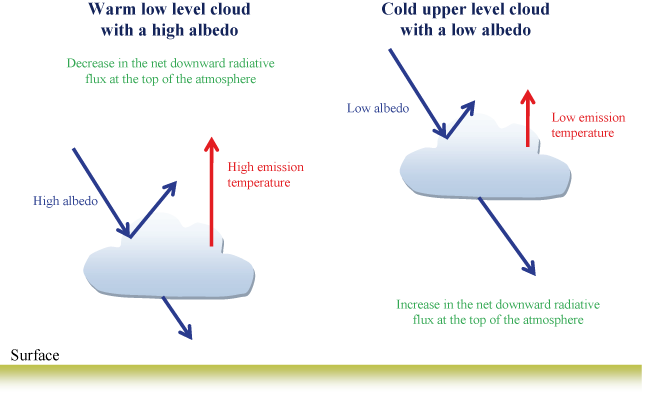4.2.2 Cloud feedback
Clouds affect the Earth's radiation budget in a variety of ways (Fig. 4.11). On the one hand, their presence tends to reduce the longwave emission from the Earth because their tops, thanks to their relatively high altitude, emit at a lower temperature than the surface. On the other hand, clouds reflect a significant amount of the incoming solar radiation, resulting in a net decrease in the amount of solar radiation absorbed by the Earth (see section 2.1.6). These two effects are often referred to as longwave and shortwave cloud radiative forcing (CRF). The shortwave CRF appears to be dominant on average in present-day conditions, and the clouds thus induce a reduction of the net downward radiation flux at the top of the atmosphere which is estimated to be around 20 Wm-2.

|
However, the cloud radiative effect varies strongly with location and season. It is also very different for the various cloud types (Fig. 4.11). For instance, low level clouds tend to be relatively warm and thus have a small impact on the upward longwave flux while they have generally a large albedo. They are thus associated with a reduction in the net radiative flux at the top of the atmosphere. By contrast, the majority of the high level clouds induce a higher radiative flux there, as they are cold and have a lower albedo.
As a consequence, an analysis of cloud feedback must take into account, for the different regions of the globe, the changes in the fraction proportions of different cloud types, cloud temperatures (in particular related to cloud height) and cloud's radiative properties as a response to a perturbation. All these changes can be caused by direct thermodynamic effects, by the large-scale dynamics that influences changes in temperature and humidity as well as by small-scale processes occurring in the clouds themselves (called cloud microphysics).
Because of the complexity of the processes, cloud feedback is one
of the less well-understood feedbacks, and this uncertainty is largely responsible for
the spread of climate sensitivity in the present generation of climate
models. The mean value provided by these models is




